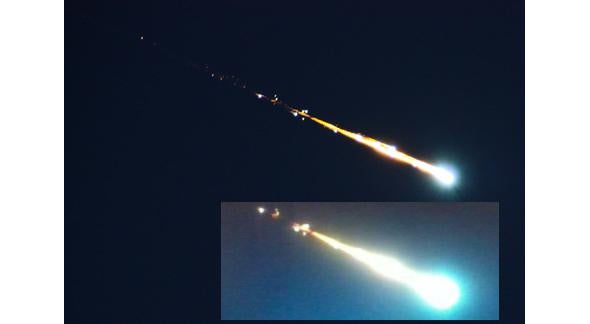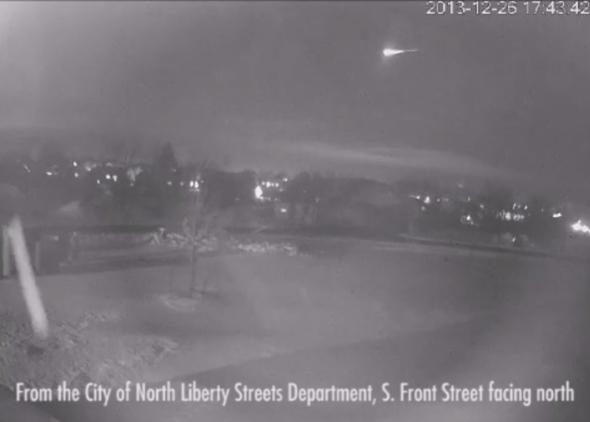In the span of two days, the U.S. Midwest was treated to two separate but dramatic bright meteors, colloquially called fireballs (and technically called bolides).
The first was on Dec. 26 at 23:44 UTC (17:45 local time, though it spanned two time zones). This bright meteor was seen by thousands of people; it was the third most heavily reported fireball by the American Meteor Society. It traveled east to west and was seen in more than a half dozen states. A lot of people reported it being as bright as the Sun, though that may be exaggerated; when these occur against a dark sky, they seem brighter than they really are.
Either way, though, it was a decently bright event! I’ve only seen one good video, from a security camera in North Liberty, Iowa, near Iowa City:
As you can see, it flashed brightly several times—probably marking times when the meteoroid itself broke apart, creating big, sharp, explosive releases of energy—and there are hints of pieces falling off.
More on this event in a sec … but I want to acknowledge that a second (unrelated) fireball was seen over roughly the same area on Dec. 28 at 04:20 UTC (22:20 local time). This was also widely reported to the AMS, including folks saying they heard explosive sounds! That’s rare, but does happen in larger events; they can generate a shock wave that travels to the ground and can be heard (also, separate explosive events as the meteoroid falls apart can make a lot of noise). This is what happened in Chelyabinsk earlier in 2013, but of course that explosion was a wee bit bigger.
Huge fireballs are dramatic events and can really be stunning, especially to people who aren’t familiar with them. I’ve seen thousands of meteors, but only a couple of really bright ones, and they stun me. So of course the first thing many people do after seeing one is go online to Twitter to talk about it.
… and of course, some people go online to fake pictures of them. That happened recently with a Mexican fireball, and I’ve seen it many other times in the past. Someone posts a fake picture on Twitter, and it rapidly goes viral because no one checks to see whether it’s real. That happened with the Dec. 26 fireball too. Within minutes of the event I saw a photo going around Twitter (prominently posted on a news site as well) that I knew I had seen before. It only took me a few minutes to track it down: It was from a bright meteor over the Netherlands in 2009. See for yourself:

Original fireball photo by Robert Mikaelyan via National Geographic.
On the top is the picture of the Netherlands fireball, and below it the picture that went around on Dec. 26. You can see they’re the same meteor, with the new one having the brightness ramped up a bit.
I know there’s no stopping this kind of thing, but let me make this request anyway: If there’s a bright meteor, and someone posts a picture of it, you can contact me via Twitter and I’ll take a look to check its veracity.
Or you can check for yourself! It’s super easy: Save the image to your computer, then go to Google Image Search. Drag the picture into the search field, and Google will then find similar images. Many times, you’ll be able to tell right away whether this is actually from some other event. That’s what I did on the 26th.
I know that people sharing a fake meteor picture isn’t (har har) the end of the world, but in my opinion it does damage. It degrades our ability to tell real from fake, fact from fiction. This is a big problem with the younger crowd, which grew up with the Internet and doesn’t have enough healthy skepticism of what it sees on it. But it’s endemic; people get excited and sometimes drop their skeptical attitude. That’s why we get these widespread fake pictures and false claims on Facebook, Twitter, and other instant social media.
I think it’s a good idea to slow down and/or stop the propagation of this kind of junk info when we can. It makes the world a better place, where we can appreciate reality for what it is. And reality’s usually way cooler than the fake stuff anyway.
